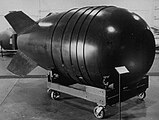Mark 6 nuclear bomb

The Mark 6 nuclear bomb was an American
The Mark 6 was in production from 1951 to 1955 and saw service until 1962. Seven variants and versions were produced, with a total production run of all models of 1100 bombs.
The basic Mark 6 design was 61 inches (150 cm) in diameter and 128 inches (330 cm) long, the same basic dimensions as the Mark 4. Various models of the Mark 6 were roughly 25% lighter than either the Mark 4 or Fat Man, and weighed 7,600 to 8,500 pounds (3,400–3,900 kg).
Early models of the Mark 6 used the same 32-point implosion system design concept as the earlier Mark 4 and Mark 3; the Mark 6 Mod 2 and later used a different, 60-point implosion system.
Various models and
Survivors
There are several Mark 6 casings on display:
- Defense Nuclear Weapons School on Kirtland Air Force Base in Albuquerque, New Mexico
- Cold War Gallery of the National Museum of the United States Air Force in Dayton, Ohio
- Museum of Aviation (Warner Robins) in Warner Robins, Georgia
- Hill Aerospace Museum in Ogden, Utah
Variants
Mark 13
The
Mark 18
The
XM1 Atomic Demolition Munition
An Atomic Demolition Munition, the XM1 was developed. Few details on the system exist.[1]
Gallery
-
The XM1 ADM that contained a Mark 6 nuclear warhead
See also
References
- OSTI 1467305.
External links
- Allbombs.html list of all US nuclear warheads at nuclearweaponarchive.org





